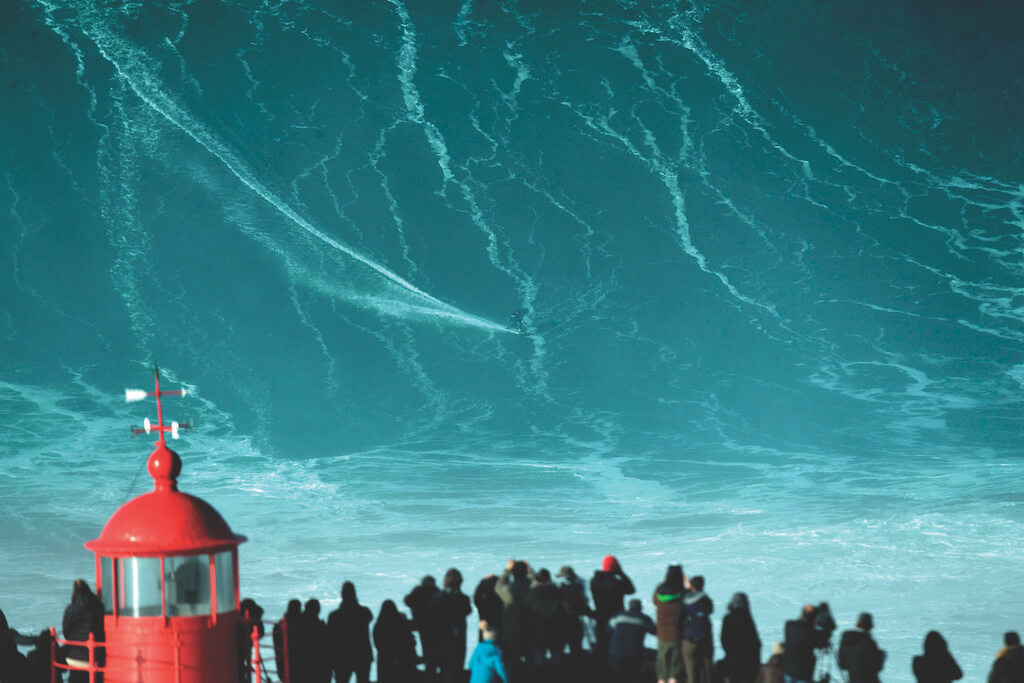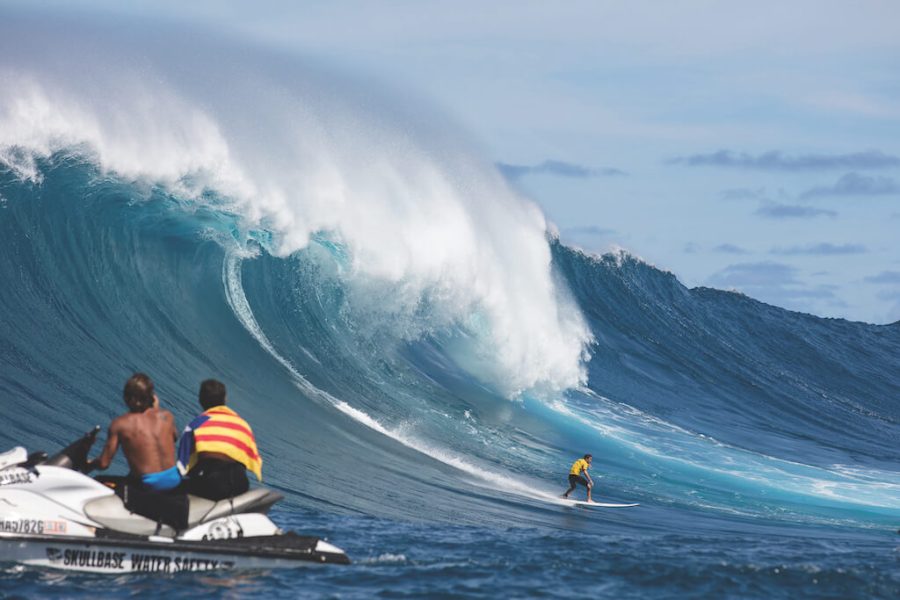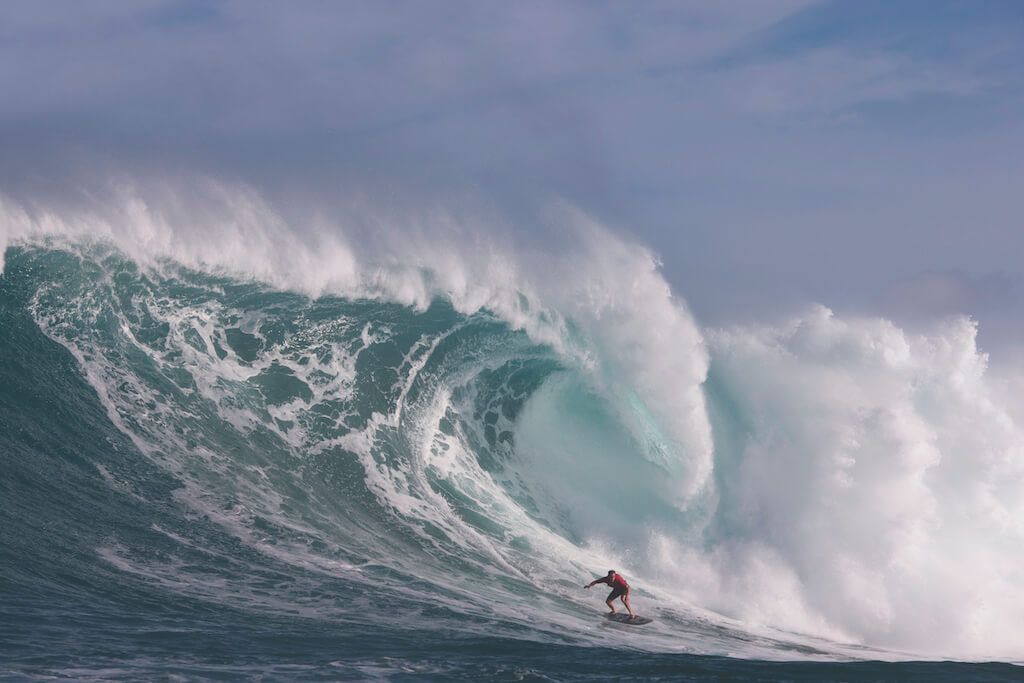Matt Majendie travels to Nazaré, Portugal, to meet the daredevil surfers risking life and limb to conquer the biggest waves on the planet.

Portugese pro Nic von Rupp | Photo: Mendo de Dornellas
Nic von Rupp still possesses the school books he repeatedly defaced in class: doodles of breaking waves scattered across the pages. He would infuriate teachers with the stock answer when asked about his career plans for the future.
“I only ever wanted to be a pro surfer,” says the Portuguese native, a decade after realising that dream. But while the aspiration was to surf the smaller, competition waves – a discipline making its Olympic debut later this year – now the chase is not gold, but the biggest wave imaginable.
The 29-year-old is among an eclectic mix of surfers aiming to become the first to successfully tackle a 100-foot wave, a sporting achievement as unthinkable as the sub-two-hour marathon once was, before Eliud Kipchoge’s achievement last year on the streets of Vienna.
At present, the record stands at 80 foot, achieved by Brazilian Rodrigo Koxa last year in Nazaré, the Portuguese fishing port which has become the mecca of big-wave surfing – beginning to rival Hawaii, the place where the discipline first originated, as its global heartbeat.
Nazaré acts as both a playground and workplace for the likes of von Rupp. There he boasts a Monster-emblazoned warehouse: a plethora of surfboards stacked up on one wall, inflatable vests to protect him when hit by a big wave on the other, and at its centrepiece the jet ski predominantly driven by Sergio Cosmos, the man dubbed a “guardian angel” by surfers, so daring are his successful rescue attempts.

German Sebastien Steudtner drops a wave during a surf session in Nazaré as awe-struck spectators watch on from the famous lighthouse | Photo: Francisco Leong/Getty Images
Big waves, bigger risks
That said, there have been lives lost to the big waves in the past, including some of surfing’s biggest names, from Ace Cool to Mark Good and Malik Joyeux. None so far have lost their lives at Nazaré. But the father of the big-wave surfing movement in the town, Garrett McNamara, says it will only be a matter of time.
“It really baffles me that no one has died here yet,” he says of waters where his wife, Nicole, had her own brush with death before giving up on any big-wave ambitions. “There are so many people out there who aren’t properly prepared, putting themselves in incredibly dangerous positions.”
It was in 2010 that McNamara became the first surfer to enter the big waves at Nazaré. Within a year, he had broken the record for the biggest wave ever surfed: a 78-footer. “It’s the most known wave in the world,” he says.
“I’m so grateful that Nazaré and I found each other. It’s a fairy tale, literally a love story. I feel blessed I had the intuition to see Nazaré for the majestic, massive mystery that she is when no other surfers did.”
What makes Nazaré’s waves so special – so big – is the ocean shelf below Praia do Norte: a canyon that rapidly goes from nearly 5,000 metres in depth to just 50m, causing a monstrous power surge of water and the resulting big waves, each break coming in three or four peaks. This succession of waves means a quick exit from any wipeout is imperative.
Things regularly go wrong, and the safety crews in the water and on the beach are there for damage limitation. “It’s the speed that gets you when the wave sucks you up,” says von Rupp. “You get drawn up the lip, it brings you down and explodes you in every sense. It brings every level of thought through your mind in that moment. There’s the hope, the fear, the fighting spirit.”

British surfer Andrew Cotton shows the wave that broke his back in 2017
Close calls
Each surfer has their own stories of near misses. It was in Nazaré’s waters that Rafael Tafia, a wine importer when not on his board, nearly lost his life. But rather than being put off, he bought an apartment in the town and now lives there for the season, which spans November to April.
“I made a mistake and almost drowned, but I knew this was the place. I had to be here,” he says. “I’ve had a lot of close calls around the world, but my top ten have all been here. It’s just so much bigger and stronger than anywhere else. Anyone that’s taken one on the head here knows it’s in a league of its own. If you don’t feel the fear, you have something wrong.”
The surfers regularly burst ear drums on any given day, and the British surfer Andrew Cotton broke his back in the waters, before rupturing his anterior cruciate ligaments just weeks after returning from 18 months out.
“Before the first swell of the season,” says Cotton, “I was like, do I really need this? Do I want this? That plays on your mind, but once you’re on the rope being towed in by the jet ski, you know you want it.”
Cotton’s occasional surf partner, the other leading light in British big-wave surfing, Tom Butler, had to have plastic surgery to reattach his ear when it was partially severed in one fall and, on another occasion, his lungs filled with a jelly-like substance which, he says somewhat proudly, “happens to a lot of people in car crashes”, so similar is the level of impact.
Recently, the surfers have started wearing GPS trackers to measure the speed they travel on the water, but also the G-force it entails. Their every move, meanwhile, is regularly filmed by drones in the skies above and by onlookers on the clifftops, who flood in their thousands each day from around the globe. There are ‘spotters’, too, who use walkie talkies to guide jet ski riders and surfers into the best waves and tell them when to avoid danger.
The speed with which they scythe through the water is astonishing – each time met with a loud cheer – and the violence with which they fall is even more striking, and hard to watch. Back on dry land, they’re treated like modern-day heroes.
For those in the water, Nazaré is the ultimate. As surfer Antonio Silva puts it – written on a plaque in the small museum at the lighthouse that oversees the waves – “Climbers have Everest, surfers have Nazaré.”
Jet rescue
But Cosmos argues the surfers are not the stars of these waters. “I have a machine, in this jet ski, that can save a life or take you out of a bad position,” he says. “I’m so glad that no one has died but, when you compete with Mother Nature, it is really hard to win. If Mother Nature wants, she lets you live and surf. The most important thing here is not the guy in the water but the driver.”
For von Rupp, who doubles up as a safety jet ski driver when not surfing, it’s all about the battle with the ocean. “It’s a constant challenge to see if you can go further, deeper and try harder. That’s what motivates me. We know our limits, we understand ourselves and whether in that moment it’s right to go or not go.
“But big-wave surfing is hard. You get beaten up a lot, it hurts, it’s uncomfortable, you have to wake up early in the morning and get beaten up until night. It’s not the most pleasant side of surfing, but I love it because I know I can make the most of my waves.”
There is no world champion. Instead, the surfers are measured by three main competitions in any given year, but also by who surfs that season’s biggest wave – von Rupp was among the five recently shortlisted. All are tied by the fact that this is their obsession, their drug, and the fact it’s almost impossible to explain why they do it to those on land.
“When I’m the most pissed off, that’s when magic happens,” says von Rupp. “When I’m angry, I just risk a lot more. That’s where I get my fuel from: when I’m against the fence.”










